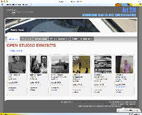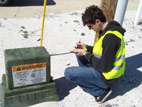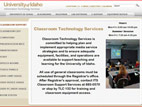Campus Technology Innovators Awards 2010
We scoured 448 worthy entries to find 11 shining examples of technology innovation in higher ed.
- By Meg Lloyd, David Raths
- 08/03/10
Each year in judging the Campus Technology Innovators awards, we have the privilege of reading through hundreds of fascinating examples of technology innovation on campus. Nominated projects cover the gamut of technology areas, from assessment and advising to wireless and web 2.0.
Yet invariably, certain trends emerge. Part of our entry form includes a section for keywords to describe the nominated project, and an analysis of the terms entered there yields some interesting data. Out of 448 total entries, 143 used the keyword “learning” and 87 referred to “student”—a testament, perhaps, to the ultimate purpose of many campus technology initiatives. Also scoring high on the list: “online,” “video,” “virtual,” and “collaboration.” Words with the lowest frequency included “telecommunications,” “accessibility,” and “e-commerce.”
This year, we also instituted six entry categories: Leadership, Governance, and Policy; Teaching and Learning; Student Systems and Services; Administrative Systems; IT Infrastructure and Systems; and Education Futurists. Teaching and Learning was the most popular category, commanding about 31 percent of the entries. IT Infrastructure and Systems was a close second, with 28 percent of the entries. And the least-populated (though certainly no less important) category was Leadership, Governance, and Policy, with only 5 percent of the entries.
We heartily congratulate this year’s 11 Innovator award winners. These top-notch university administrators, faculty, and staff demonstrate the vision and leadership needed to take technology investment to new heights on campus, and truly serve as models for others to follow. Worthy of acknowledgement, too, are the campus/vendor partnerships forged to support these innovative technology initiatives and see them through.

Leadership, Governance and Policy
Western Carolina University
To better support academic technology on campus, WCU created a data-focused faculty resource center that crosses the boundaries of IT and academic affairs. read more...

Teaching and Learning
Duke University
A Twitter soap opera teaches nurses about patient care, privacy, quality, and safety from the eyes of a medical simulation mannequin. read more...

Teaching and Learning
Penn State University
An effort to facilitate the online submission of studio arts assignments developed into a full-blown web-based arts studio, complete with galleries, peer feedback, and rubrics-supported instructor evaluation. read more...

Teaching and Learning
Auburn University
Students have used geospatial technologies to map more than 12,000 infrastructure elements along miles of Alabama’s Gulf Coast, enabling emergency responders to find critical utility points to restore services in the wake of natural disasters. read more...

Student Systems and Services
University of California, Irvine
A home-grown bike-sharing program is made possible by a sophisticated technological back end, helping the southern California campus reduce the number of abandoned bikes and cars on the road.. read more ...

Administrative Systems
Wayne State University
A custom-built dashboard at WSU provides faculty and grant administrators with a seamless tool for managing grants and accessing real-time data. read more...

IT Infrastructure and Systems
Syracuse University
A prototype video management system, designed to make it easy and cost-effective for Syracuse constituents to publish video content, has gone on to transform video management across the university and at other schools as well.read more...

IT Infrastructure and Systems
University of Idaho
UI developed a comprehensive classroom technology monitoring and early warning system, enabling a small group of technicians to provide top-notch faculty and equipment support. read more...

IT Infrastructure and Systems
Purdue University
By centrally managing its supercomputing clusters, this Big 10 research university provides more power to more faculty with more efficiencies at less cost. read more...

Education Futurists
Darton College
This Georgia institution is using motion capture technology to develop detailed virtual anatomical models and study the kinesthetics of dance. read more...
Meet the Judges
This year, CT introduces a new evaluation process for the Campus Technology Innovators award program. Entries were reviewed by our Innovators Judging Committee, a group of higher ed tech leaders, many of whom are former Innovators themselves. (Final winners were chosen by our expert team of editors.)
Ruth Ann Balla Executive Director, Virtual College Miami Dade College (FL)
Trent Batson Executive Director The Association for Authentic, Experiential, and Evidence-Based Learning
Judith Boettcher Consultant and Author Designing for Learning
Edward Chapel Vice President for Information Technology Montclair State University (NJ)
Mary Jo Gorney-Moreno Associate Vice President, Academic Technology San Jose State University (CA)
Susanna Wong Herndon Director, Technology-Enhanced Learning, Division of Instructional Innovation and Assessment University of Texas, Austin
Joeann Humbert Director of Online Learning Rochester Institute of Technology (NY)
Menko Johnson Instructional Designer Stanford University (CA)
John Lawson Vice Provost for Information Technology and CIO Western Washington University
Mely Tynan Consultant and retired CIO Tufts University (MA)
Jim Wolfgang Director, The Digital Innovation Group @ Georgia College Georgia College & State University
About the Authors
Meg Lloyd is a Northern California-based freelance writer.
David Raths is a Philadelphia-based freelance writer focused on information technology. He writes regularly for several IT publications, including Healthcare Innovation and Government Technology.